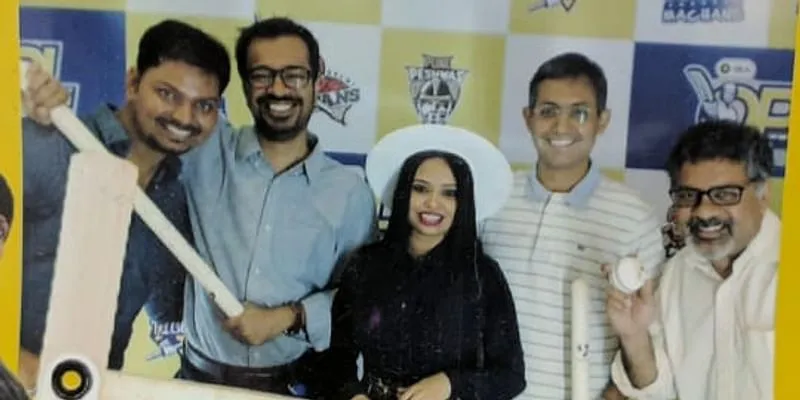[Techie Tuesday] Nitin Gupta’s ride: from Flipkart and Ola to Milkbasket's engineering chief
In this week’s Techie Tuesday, we feature Nitin Gupta, the Head of Engineering at Milkbasket. His journey has taken him places: from being part of the team that worked on the first Flipkart Marketplace and going on to build tech at Ola and help scale Foodpanda.
Nitin Gupta loves one thing most about mathematics: the push towards solving problems.
That is what prompted him to tackle math problems of Class 10 when in Class 7, and even take tuitions for students of higher classes. This love for problem solving helped Nitin lead teams, and work in the core engineering teams of , , , and now .
“I am a hands-on guy. I like coding, and even today I code as much as possible. I love to do code reviews too,” Nitin says.

Nitin Gupta
The background
Nitin was born in Alwar, Rajasthan. His father was a popular math teacher, and his mother was a homemaker.
“My father had studied in Hindi medium, and was known for his math skills. I would take the English-medium CBSE curriculum classes for him,” Nitin recalls. This was despite Nitin attending a Hindi-medium school until Class 10.
He helped students, working on CBSE's English-curriculum mathematics on the side, out of “personal interest”. He went on to do what most students in Rajasthan did - go to Kota, the “Mecca of IIT coaching”, in 2004.
Nitin joined the reputed Bansal classes and enjoyed the challenge of the training and push towards self-discipline. He took the exams for both IIT and AIEEE for IIIT Hyderabad.
“I preferred IIIT Hyderabad and didn’t focus much on IIT. But I got through IIIT Hyderabad, and went there for my computer science engineering in 2005,” Nitin recalls.
Working with computers
It took a few months for Nitin to get used to English as a primary medium of education and to living in a different state and culture. His one year away from home in Kota helped.
“For me, the core was the computer. English and Hindi are not important to the computer. I knew the languages the computer understood; that is what mattered,” he says.
This was the first time that Nitin had access to his own laptop and PC; till now, he had accessed computers at cyber cafes in Alwar and Kota.
Every time Nitin worked on a system, he felt the system had a lot to offer. His first program after joining IIIT Hyderabad was to create a calculator.
“I realised that it was all about fundamentals, basic principles, and how you work around them. I learnt that fundamentals need to be strong at college. It is the one learning I took throughout my tech journey. Ensure that the basic first principles are strong, and everything will fall in place,” he says.
He adds that working with different students taught him to be a team player. “It gave me a lot of exposure to what was happening in the technology world.”
In 2009, campus placements took Nitin to online poker company Party Gaming, which was acquired by US-based company D-Win. Party Gaming was one of the first few startups to be listed in the stock market in 2005.

Nitin Gupta
Gaming his way up
While Nitin was impressed by Founder Anurag Dixit’s journey and the startup, he felt things could have moved faster.
“In 2010, if someone says they are okay with three hours of downtime on their website because a new game was being launched, there is a problem. Everyone was aware of hot deployment strategy. I couldn’t take it silently, and - despite being a fresher - would keep going to the higher-ups and management and say I could help with hot deployments,” he recalls.
Nitin soon realised that it wasn’t just about pitches or talks. He developed a game to show how the core infrastructure could be changed to make implementation faster.
“I learnt at Party Gaming that hard work was more important than pitches and presentations. Only by doing something can you prove yourself,” Nitin says.
Looking at his work and attempt to implement new things, many suggested that Nitin should try working for a new-age startup.
Working at Flipkart
In 2011, Nitin left Party Gaming and came to Bengaluru, centre to most startup activity in India then. Flipkart was a new kid on the block.
“Everyone told me it was tough to crack the Flipkart interview. That made the prospect more appealing,” says Nitin, adding that he got into the ecommerce giant.
Calling his first startup experience “special”, Nitin says his first project was to rewrite and re-architecture everything at Flipkart.
“Sachin (Bansal) was heading the initiative with a team of 15 people. We were moved from the corporate office to the two-bedroom house where Flipkart was born in 2008. The vibe - everyone was eating, breathing, and sleeping architecture, technology, and networks - made me feel I was at the right place,” Nitin says.
He may have been the most junior member on the team, but Nitin was a part of the team that built the first Flipkart Marketplace, which was launched six to eight months later.
“I learnt how to build scalable services, with a small team. It is important to think long term and build for at least a few years,” says Nitin, who focused on the procurement vertical.
Riding to Ola
Nitin, however, wanted to understand how the whole architecture and infrastructure worked. And in December 2012, he decided to join Ola after a half-hour meeting with Co-founder and CTO Ankit Jain.
“We met and Ankit just said ‘Sab kuch banana hai’ (we need to rebuild everything). He had me there. I knew there would be a high learning curve at Ola, and that was the reason I left Flipkart, the then fastest growing startup,” Nitin says.
Back then, Ola was a small company with 1,000 to 3,000 transactions a day. The team comprised 15 engineers and a few product managers.
“I didn’t think of ESOPs or compensation; I just focused on learning. I was lucky that I moved at the right time.”

Nitin Gupta with Ankit Bhatti, Co-founder and CTO, Ola
Nitin began by working on Ola’s core architecture. He explains that there is a customer demand and a supply of cars on the backend systems. The first task for the system is to understand which car needs to be assigned to which customer. This was initially done manually - a human would match the demand with supply.
“We began creating algorithms to find the best way to allocate a car. It was a basic tech step. The next step was creating a little more complex marketplace. If in one area, you want to prioritise profitability, the setup changes to create pricing and costing in a manner that aids this. If you want to generate more demand and transactions, the systems change again. These shifts and levers would be made based on business strategies,” he says.
At Ola, Nitin also realised the importance of sharp execution skills along with a strong vision. In 2013, he worked on building the pricing engine, which was completed in two days. The problem of corrections on billing amounts meant “48 hours of continuous development and deployment”.
Working on Ola Stores
By 2014, Ola was growing and the team was looking to diversify. Nitin was asked to look at building new products, and he began with Ola Stores, when grocery was one of the areas the ride-hailing giant was looking at.
Nitin had only five years of work experience by then, but says it felt like 15 years as the “opportunities were of that level”. Ola Stores was one of the things Nitin built from scratch.
“Every single engineer was hired by me as it was a new vertical and division. While we had to shut operations after a year, even today I would say it was a beautiful product. Everything was new and intuitive,” he recollects.
Nitin then joined the ride experience team, and started heading the vertical, focusing on the customer side of the app. The team of 150 people was working on several different patented technologies.
“We had to ensure that the ride experience kept getting better. We needed focus on maps and navigation, building our own maps. We built that by taking core movement, speed, and traffic. This also helped get more insight on riders and their experience.”
He also worked on the trust systems, to ensure reduction in driver-related frauds. The OTP on the Ola platform is one such initiative.
Scaling Foodpanda
When he was wondering what next, Nitin was, in 2017, given the task of scaling the newly acquired foodtech platform Foodpanda.
As the CTO of Foodpanda, the first order of business was to make it a tech company. “I realised it wasn’t a tech company. There were a few engineers and most of the work was done in Germany,” says Nitin, adding that the code was breaking practically every day.
It was like creating a startup from scratch, and Nitin knew he had to build technology that went hand in hand with the business strategy.
“Every technology you build should have some ROI. You need to maintain costs; you don’t build for the sake of building. We wanted to hit a scale of 50x in two weeks, but tech was not holding even for 2x scale. It was my biggest challenge,” he says.
The Foodpanda journey was a huge learning experience. “I built it in three weeks, and it taught me so much. I recollect staying in office for four days, and seeing the impact of what I was doing. That helped me take on the Milkbasket journey with ease,” Nitin says.
The core problem of the food business is cost of delivery, as it has the highest burn. Nitin explains they were able to get into individual D-Meshes, so every 50 square metre area could be treated differently.
This involved two dimensions: space and time. Depending on the strategy, the algorithms would decide whether the deliveries would be back to back or single run. This meant aggregating demand and working on supply based on space availability and time you allocate the supply.
“We were able to do this in three weeks, with a strong team. Whatever scale we were able to achieve - at Ola and Foodpanda - was because of the team,” Nitin says.
The move to Milkbasket
Work was great at Ola, but Nitin was not happy on the personal front. With his father unwell, he wanted to move closer to Rajasthan. He decided to move to Delhi, and his Milkbasket journey started in 2019.
“I wanted to learn more about consumer experience and behaviour, and Milkbasket felt like the best bet. Milkbasket’s scale and the consumer love it has received made it seem like the best place for me.”
Nitin is currently working on scaling the core tech systems at MilkBasket. This is apart from ensuring that they continue with non-contact and non-checkout delivery.
“Every technology you build has a journey. You cannot maintain something that is over or under-engineered. You need to go with time, understand the problem statement, and work on technology accordingly. You need to have a clear picture on how you want your application to behave, the scalability, and the cost. It is important to create data points and insights with the technology you build,” Nitin says.
Edited by Teja Lele






![[Techie Tuesday] Nitin Gupta’s ride: from Flipkart and Ola to Milkbasket's engineering chief](https://images.yourstory.com/cs/2/a9efa9c02dd911e9adc52d913c55075e/Nitin-Gupta-TT-1589195386261.png?mode=crop&crop=faces&ar=2:1?width=3840&q=75)




